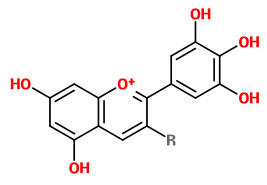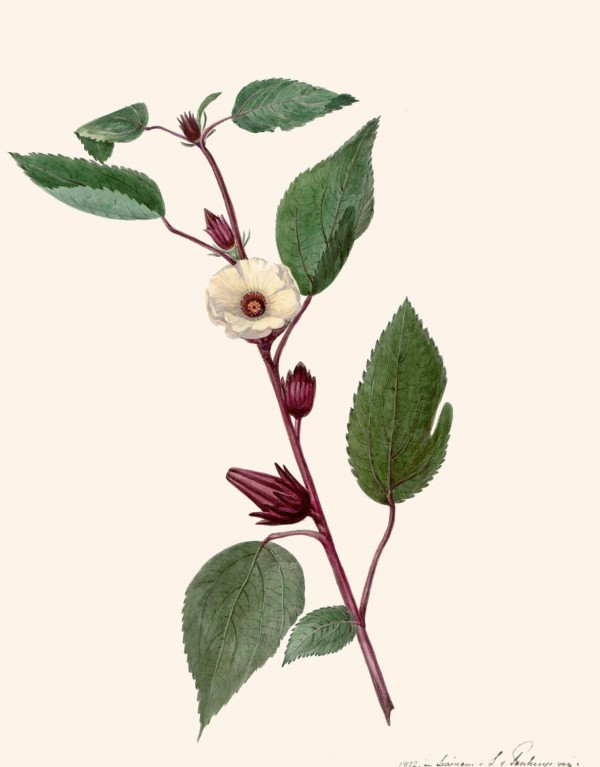Hibiscus sabdariffa L. - Malvaceae - red sorrel, Jamaica sorrel, roselle, Roselle, Hibiscus, Sudan-Eibisch, Rama, Afrikanische Malve, Karkadé
Erect annual herb, up to 2m tall, probably native to West Africa, cultivated and naturalized throughout tropics; stems robust, purplish; leaves dimorphic; blades on proximal part of stem ovate, those on distal part of stem palmately 3-lobed, lobes lanceolate; flowers solitary, axillary, calyx purplish, cup-shaped, corolla yellow with dark red center, 6-7cm in diameter. „The fleshy calyx and epicalyx are edible, both fresh as a vegetable and dried as a tea.“ http://www.efloras.org/florataxon.aspx?flora_id=2&taxon_id=200013718
„The major pigment, which was formerly isolated from the calyx and bract of roselle (Hibiscus sabdariffa L.) by Yamamoto et al. (1933), was reported to have the structure of delphinidin pentosido-glucoside. It was newly examined and found that it consists of each 1mol of delphinidin (1mol), glucose and xylose. By a series of analytical procedure its structure must be delphinidin 3-xylosido-glucoside. So it was compared with daphniphyllin (delphinidin 3-xylosido-glucoside), which was isolated from the berries of Daphniphyllum macropodum Miq. and it revealed their identity. Hence, the name “hiviscin”. once given to this substance, must be eliminated from the literature.
As minor pigments, a small amount of delphinidin 3-monoglucoside [= myrtillin], cyanidin 3-monoglucoside (chrysanthemin) and delphinidin were also isolated in crystalline state from dried calyx and bract.“
[Reexamination on the structure of so-called “Hiviscin”., Shibata, M., Furukawa, M., 植物学雑誌 (Shokubutsugaku Zasshi), 82(974-975), 1969, 341-347]
 delphinidin (R= OH), hiviscin (R= O-xyl-gluc), myrtillin (R= O-gluc)
delphinidin (R= OH), hiviscin (R= O-xyl-gluc), myrtillin (R= O-gluc)
The mucilage-forming polysaccharides of H.sabdariffa flower calyces consist mainly of uronic acid (50%) and arabinose, glucose, xylose, mannose and rhamnose.
[Portrait einer Arzneipflanze: Hibiscus sabdariffa-Hibiscusblüten., Franz, M., Franz, G., Zeitschrift für Phytotherapie, Vol.9, 1988, 63-66]
„The calyx and epicalyx are persistent and are collected in the fruiting stage. These edible and sweet-sour structures are known as 'hisbiscus flowers' [Hibisci flos, Flores Hibisci sabdariffae]… Sugars and acids contribute to the refreshing taste. The polysaccharides might have mild immun-modulating activity; they form a protective film on inflamed mucosal tissues. Anthocyans provide color and some antioxidative effects. The laxative effect can be explained by the presence of organic acids that cannot be resorbed…“
[Medicinal Plants of the World. Ben-Erik Van Wyk and Michael Wink, Pretoria 2004, 170]
„The species H. sabdariffa comprises a large number of cultivated types which, on the basis of their growth habit or end use, are classified broadly under two varieties, H. sabdariffa var.sabdariffa and H. sabdariffa var.altissima Wester. Former is generally bushy and pigmented and cultivated for the edible calyces; the latter includes tall-growing, unbranched types bearing inedible calyces and mainly cultivated for the stem fibre, roselle.
The plant is reported to contain proteins, fats, carbohydrates, flavonoids, acids, minerals and vitamins. The plant has been reported to have antihypertensive, hepatoprotective, antihyperlipidemic, anticancer and antioxidant properties. “
[Hibiscus sabdariffa Linn.-an overview., Mahadevan, N., Shivali, K.P., Kamboj, P., Natural product radiance, Vol.8(1), 2009, 77-83]
http://nopr.niscair.res.in/bitstream/123456789/3769/1/NPR%208%281%29%2077-83.pdf
„The anthocyanins delphinidin-3-O-sambubioside (1) and cyanidin-3-O-sambubioside (2) were isolated by bioassay-guided purification. These compounds showed IC50 values (84.5 and 68.4 μg/mL, respectively), which are similar to those obtained by related flavonoid glycosides. Kinetic determinations suggested that these compounds inhibit the enzyme activity by competing with the substrate for the active site… The competitive ACE inhibitor activity… is in good agreement with the folk medicinal use of Hibiscus sabdariffa calyces as antihypertensive.“
[Inhibition of angiotensin convertin enzyme (ACE) activity by the anthocyanins delphinidin-and cyanidin-3-O-sambubiosides from Hibiscus sabdariffa., Ojeda, D., Jiménez-Ferrer, E., Zamilpa, A., Herrera-Arellano, A., Tortoriello, J., Alvarez, L., Journal of ethnopharmacology, Vol.127(1), 2010, 7-10]
„Calyxes from the Roselle plant (Hibiscus sabdariffa L.) were used to prepare cold (22 °C for 4 h) and hot (98 °C for 16 min) infusions/teas from both fresh and dried forms. Aroma volatiles were extracted using static headspace SPME and analyzed using GC-MS and GC-O with 2 different columns (DB-5 and DB-Wax). Totals of 28, 25, 17, and 16 volatiles were identified using GC-MS in the dried hot extract (DHE), dried cold extract (DCE), fresh hot extract (FHE), and fresh cold extract (FCE) samples, respectively. In terms of total GC-MS peak areas DHE ≫ DCE > FHE ≫ FCE. Nonanal, decanal, octanal, and 1-octen-3-ol were among the major volatiles in all 4 beverage types. Thirteen volatiles were common to all 4 teas. Furfural and 5-methyl furfural were detected only in dried hibiscus beverages whereas linalool and 2-ethyl-1-hexanol were detected only in beverages from fresh hibiscus. In terms of aroma active volatiles, 17, 16, 13, and 10 aroma active volatiles were detected for DHE, DCE, FHE, and FCE samples, respectively. The most intense aroma volatiles were 1-octen-3-one and nonanal with a group of 4 aldehydes and 3 ketones common to all samples. Dried samples contained dramatically higher levels of lipid oxidation products such as hexanal, nonanal, and decanal. In fresh hibiscus extracts, linalool (floral, citrus) and octanal (lemon, citrus) were among the highest intensity aroma compounds but linalool was not detected in any of the dried hibiscus extracts.“
[Hot and cold water infusion aroma profiles of Hibiscus sabdariffa: fresh compared with dried., Ramírez‐Rodrigues, M.M., Balaban, M.O., Marshall, M.R., Rouseff, R.L., Journal of food science, Vol.76(2), 2011, C212-C217]
„Hibiscus sabdariffa anthocyanin extract can act as a prophylactic by intervening as a free radical scavenger both in vitro and in vivo as well as inducing the phase II drug detoxification enzymes.“
[Antioxidant and drug detoxification potentials of Hibiscus sabdariffa anthocyanin extract., Ajiboye, T.O., Salawu, N.A., Yakubu, M.T., Oladiji, A.T., Akanji, M.A., Okogun, J.I., Drug and chemical toxicology, Vol.34(2), 2011, 109-115]
„Roselle was found to be rich in malic acid, anthocyanins, ascorbic acid and minerals, especially Ca and Fe, but low in glucose. More than 18 volatile compounds were identified by gas chromatography and gas chromatography–mass spectrometry. This herb, which is rich in phenolic compounds and displays DPPH radical scavenging activity, could be a good source of natural antioxidants. The antimicrobial activity of the Roselle water and ethanol extracts was tested with Bacillus subtilis (ATCC6633), Staphylococcus aureus (ATCC6538) and Escherichia coli (ATCC 8739). The inhibition of the Roselle ethanol extract against B. subtilis and S. aureus was slightly higher than that of water extract but this difference was not significant. However, E. coli was strongly inhibited by the Roselle water extract at concentrations of 25 and 50 mg mL−1 as determined by a paper disc method.“
[Physicochemical properties and antimicrobial activity of Roselle (Hibiscus sabdariffa L.)., Jung, E., Kim, Y., Joo, N., Journal of the Science of Food and Agriculture, Vol.93(15), 2013, 3769-3776]
„The available information on H. sabdariffa shows a wide range of traditional as well as potentially new health applications and therapeutic targets associated with such uses. More robust, randomised, controlled clinical trials would be desirable with well-characterised Hs preparations to corroborate its beneficial effects in pre- and mildly-hypertensive patients. The same applies for its diuretic effects… The effectiveness of Hs extract for metabolic disorders like type II diabetes should be investigated further, as previous clinical studies have shown promising effects on hyperlipidemia and hypertension, conditions strongly correlated with type II diabetes or metabolic syndrome ( Hernandez-Perez and Herrera-Arellano, 2011 and Hopkins et al., 2013).“
[Da-Costa-Rocha, I., Bonnlaender, B., Sievers, H., Pischel, I., & Heinrich, M. (2014). Hibiscus sabdariffa L. - A phytochemical and pharmacological review. Food chemistry, Vol.165, 2014, 424-443]
http://www.sciencedirect.com/science/article/pii/S030881461400692X
Main volatile components of H.sabdariffa (headspace GC-MS) were furfural (31.6-38.6%) and cinnamal (13.8-14.1%). Olfactorly interesting minor components were e.g. benzaldehyde, benzoic acid, eugenol, 5-methylfurfural, and maltol (0.14-0.18%).
[Farag, Mohamed A., Dalia M. Rasheed, and Islam M. Kamal. „Volatiles and primary metabolites profiling in two Hibiscus sabdariffa (roselle) cultivars via headspace SPME-GC-MS and chemometrics.“ Food Research International 78 (2015): 327-335]
https://scholar.cu.edu.eg/sites/default/files/mfarag73/files/1-farag_et_al._food_research_international_2015.pdf

Panhuys, L. von, Watercolours of Surinam (1811-1824)
http://plantgenera.org/species.php?id_species=513432